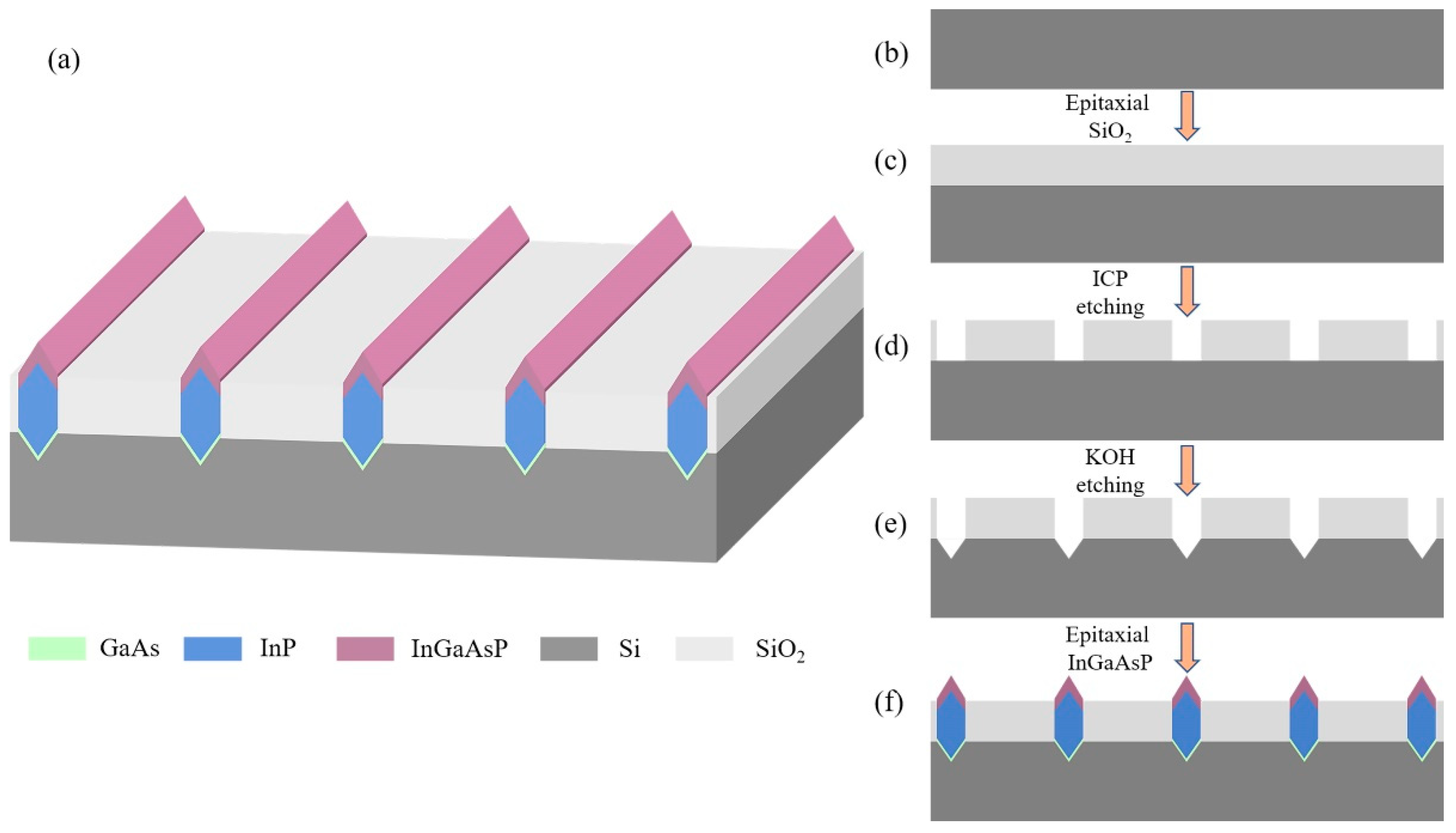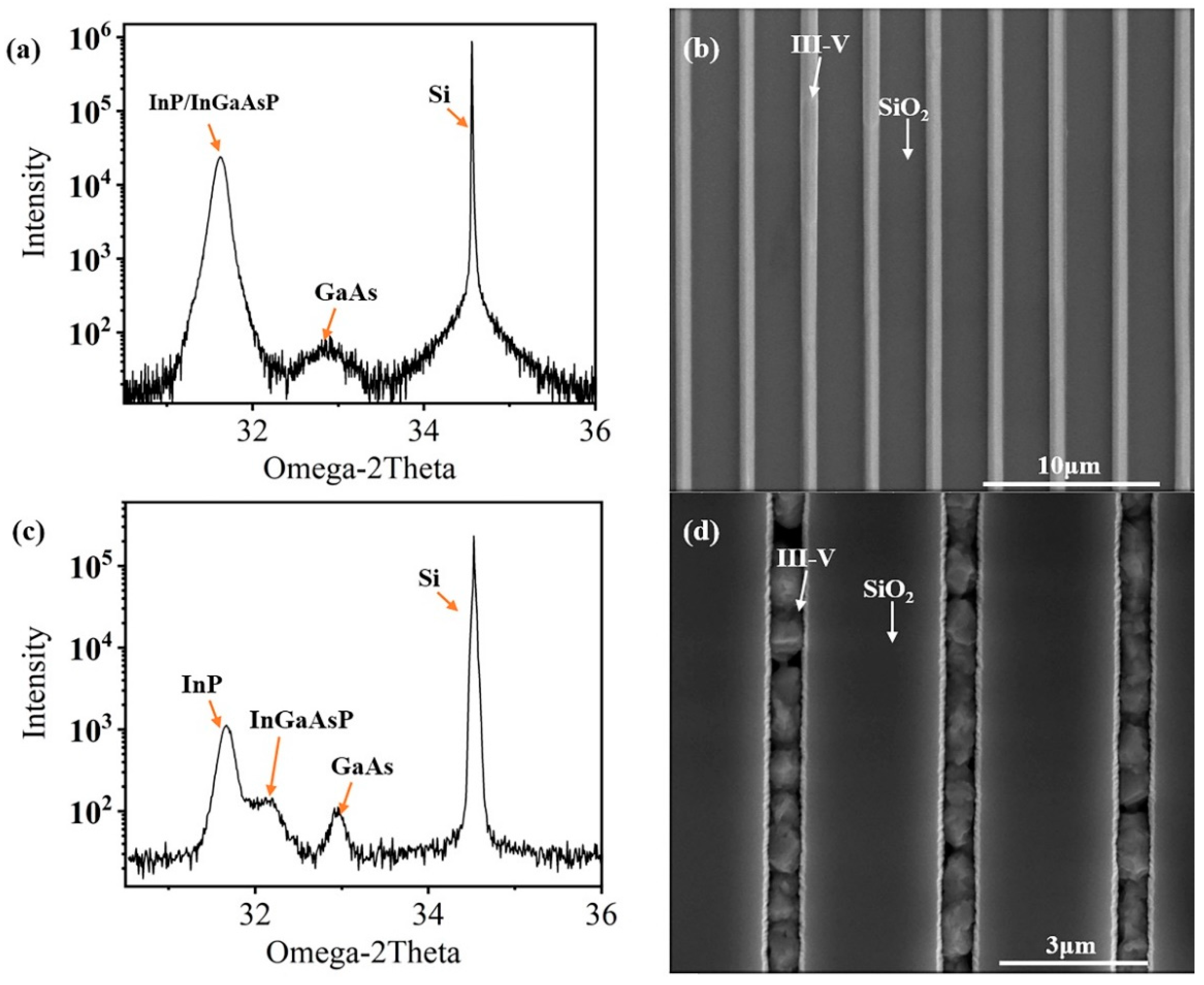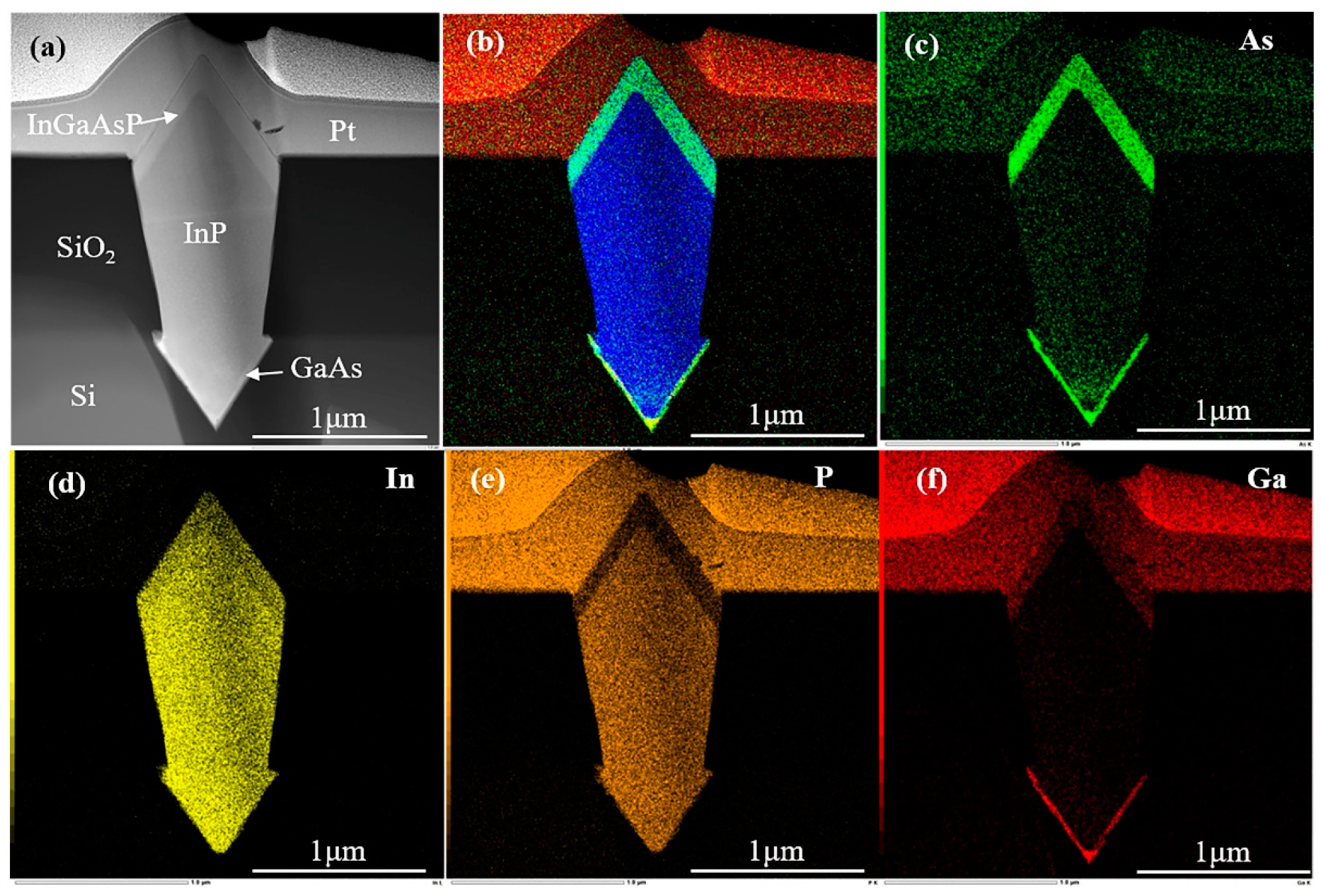Selective Growth of Energy-Band-Controllable In1−xGaxAsyP1−y Submicron Wires in V-Shaped Trench on Si
Abstract
:1. Introduction
2. Materials and Methods
3. Results and Discussion
4. Conclusions
Author Contributions
Funding
Institutional Review Board Statement
Informed Consent Statement
Data Availability Statement
Conflicts of Interest
References
- Hoefflinger, B. ITRS: The International Technology Roadmap for Semiconductors. In Chips 2020: A Guide to the Future of Nanoelectronics; Hoefflinger, B., Ed.; Springer: Berlin/Heidelberg, Germany, 2012; pp. 161–174. [Google Scholar]
- Krishnamoorthy, A.V.; Ho, R.; Zheng, X.; Schwetman, H.; Lexau, J.; Koka, P.; Li, G.L.; Shubin, I.; Cunningham, J.E. Computer Systems Based on Silicon Photonic Interconnects. Proc. IEEE 2009, 97, 1337–1361. [Google Scholar] [CrossRef]
- Gunn, C. CMOS Photonics for High-speed Interconnects. IEEE Micro 2006, 26, 58–66. [Google Scholar] [CrossRef]
- Offrein, B.J. Silicon Photonics for the Data Center. In Proceedings of the Optical Fiber Communications Conference & Exhibition, Los Angeles, CA, USA, 22–26 March 2015; p. W3A.4. [Google Scholar]
- Wang, X.J.; Zhaotang, S.U.; Zhou, Z.P. Recent progress of silicon photonics. Sci. Sin. Phys. Mech. Astron. 2015, 45, 014201. [Google Scholar]
- Duprez, H.; Descos, A.; Ferrotti, T.; Harduin, J.; Bakir, B. Heterogeneously Integrated III-V on Silicon Distributed Feedback Lasers at 1310 nm. In Proceedings of the Optical Fiber Communication Conference and Exposition (OFC 2015), Los Angeles, CA, USA, 22–26 March 2015. [Google Scholar]
- Liao, M.; Chen, S.; Hou, S.; Chen, S.; Wu, J.; Tang, M.; Kennedy, K.; Li, W.; Kumar, S.; Martin, M. Monolithically Integrated Electrically Pumped Continuous-Wave III-V Quantum Dot Light Sources on Silicon. IEEE J. Sel. Top. Quantum Electron. 2017, 23, 16904546. [Google Scholar] [CrossRef] [Green Version]
- Fiorenza, J.; Park, J.S.; Hydrick, J.; Li, J.; Li, J.; Curtin, M.; Carroll, M.; Lochtefeld, A. Aspect Ratio Trapping: A Unique Technology for Integrating Ge and III-Vs with Silicon CMOS. ECS Trans. 2010, 33, 963. [Google Scholar] [CrossRef]
- Li, J.; Bai, J.; Hydrick, J.M.; Fiorenza, J.G.; Major, C.; Carroll, M.; Shellenbarger, Z.; Lochtefeld, A. Thin Film InP Epitaxy on Si (001) Using Selective Aspect Ratio Trapping. ECS Trans. 2009, 18, 887–894. [Google Scholar] [CrossRef]
- Li, Q.; Ng, K.W.; Lau, K.M. Growing antiphase-domain-free GaAs thin films out of highly ordered planar nanowire arrays on exact (001) silicon. Appl. Phys. Lett. 2015, 106, 072105. [Google Scholar] [CrossRef] [Green Version]
- Wang, G.; Leys, R.R.; Loo, R.; Richard, R.; Bender, R.; Waldron, R.; Brammertz, R.; Dekoster, J.; Wang, R.; Seefeldt, R.J.A.P.L. Selective area growth of high quality InP on Si (001) substrates. Appl. Phys. Lett. 2010, 97, 121913. [Google Scholar] [CrossRef]
- Li, S.; Zhou, X.; Kong, X.; Li, M.; Mi, J.; Bian, J.; Wang, W.; Pan, J. Evaluation of growth mode and optimization of growth parameters for GaAs epitaxy in V-shaped trenches on Si. J. Cryst. Growth 2015, 426, 147–152. [Google Scholar] [CrossRef]
- Li, S.-Y.; Zhou, X.-L.; Kong, X.-T.; Li, M.-K.; Mi, J.-P.; Bian, J.; Wang, W.; Pan, J.-Q. Selective Area Growth of GaAs in V-Grooved Trenches on Si(001) Substrates by Aspect-Ratio Trapping. Chin. Phys. Lett. 2015, 32, 028101. [Google Scholar] [CrossRef]
- Li, S.; Zhou, X.; Kong, X.; Li, M.; Mi, J.; Pan, J. Catalyst-free growth of InP nanowires on patterned Si (001) substrate by using GaAs buffer layer. J. Cryst. Growth 2016, 440, 81–85. [Google Scholar] [CrossRef]
- Li, S.; Zhou, X.; Li, M.; Kong, X.; Mi, J.; Wang, M.; Wang, W.; Pan, J. Ridge InGaAs/InP multi-quantum-well selective growth in nanoscale trenches on Si (001) substrate. Appl. Phys. Lett. 2016, 108, 021902. [Google Scholar] [CrossRef]
- Li, Y.; Wang, M.; Zhou, X.; Wang, P.; Yang, W.; Meng, F.; Luo, G.; Yu, H.; Pan, J.; Wang, W. InGaAs/InP multi-quantum-well nanowires with a lower optical leakage loss on v-groove-patterned SOI substrates. Opt. Express 2019, 27, 494–503. [Google Scholar] [CrossRef] [PubMed]
- Han, Y.; Ng, W.K.; Xue, Y.; Li, Q.; Wong, K.S.; Lau, K.M. Telecom InP/InGaAs nanolaser array directly grown on (001) silicon-on-insulator. Opt. Lett. 2019, 44, 767–770. [Google Scholar] [CrossRef] [PubMed]
- Han, Y.; Ng, W.K.; Xue, Y.; Wong, K.S.; Lau, K.M. Room temperature III–V nanolasers with distributed Bragg reflectors epitaxially grown on (001) silicon-on-insulators. Photonics Res. 2019, 7, 1081–1086. [Google Scholar] [CrossRef] [Green Version]
- Shi, Y.; Wang, Z.; Van Campenhout, J.; Pantouvaki, M.; Guo, W.; Kunert, B.; Van Thourhout, D. Optical pumped InGaAs/GaAs nano-ridge laser epitaxially grown on a standard 300-mm Si wafer. Optica 2017, 4, 1468–1473. [Google Scholar] [CrossRef]
- Tian, B.; Wang, Z.; Pantouvaki, M.; Absil, P.; Van Campenhout, J.; Merckling, C.; Van Thourhout, D. Room Temperature O-band DFB Laser Array Directly Grown on (001) Silicon. Nano Lett. 2017, 17, 559–564. [Google Scholar] [CrossRef] [PubMed]
- Levinstein, M.; Rumyantsev, S.; Shur, M. Handbook Series on Semiconductor Parameters; World Scientific: Singapore, 1996. [Google Scholar]
- Zilko, J.L.; Davisson, P.S.; Luther, L.; Trapp, K.D.C. Improved compositional uniformity of InGaAsP grown by low pressure metalorganic vapor phase epitaxy using tertiary butyl phosphine as the phosphorus source. J. Cryst. Growth 1992, 124, 112–117. [Google Scholar] [CrossRef]






| In1−xGaxAsyP1−y | Ga | In | As | P | |
|---|---|---|---|---|---|
| Gas Molar Flow(mol/min) | |||||
| 1 | nTMGa = 3.9 × 10−6 nTMIn = 9.4 × 10−6 nAH3 = 3.1 × 10−4 nPH3 = 4.5 × 10−3 | 0.287 | 0.713 | 0.622 | 0.378 |
| 2 | nTMGa = 2.8 × 10−6 nTMIn = 9.4 × 10−6 nAH3 = 2.2 × 10−4 nPH3 = 4.5 × 10−3 | 0.265 | 0.735 | 0.575 | 0.425 |
| 3 | nTMGa = 2.2 × 10−6 nTMIn = 9.4 × 10−6 nAH3 = 1.8 × 10−4 nPH3 = 4.5 × 10−3 | 0.248 | 0.752 | 0.538 | 0.462 |
| 4 | nTMGa = 1.1 × 10−6 nTMIn = 9.4 × 10−6 nAH3 = 8.9 × 10−5 nPH3 = 4.5 × 10−3 | 0.242 | 0.758 | 0.525 | 0.475 |
Publisher’s Note: MDPI stays neutral with regard to jurisdictional claims in published maps and institutional affiliations. |
© 2022 by the authors. Licensee MDPI, Basel, Switzerland. This article is an open access article distributed under the terms and conditions of the Creative Commons Attribution (CC BY) license (https://creativecommons.org/licenses/by/4.0/).
Share and Cite
Yang, W.; Yang, Z.; Wang, M.; Yu, H.; Zhang, Y.; Wang, W.; Zhou, X.; Pan, J. Selective Growth of Energy-Band-Controllable In1−xGaxAsyP1−y Submicron Wires in V-Shaped Trench on Si. Crystals 2022, 12, 476. https://doi.org/10.3390/cryst12040476
Yang W, Yang Z, Wang M, Yu H, Zhang Y, Wang W, Zhou X, Pan J. Selective Growth of Energy-Band-Controllable In1−xGaxAsyP1−y Submicron Wires in V-Shaped Trench on Si. Crystals. 2022; 12(4):476. https://doi.org/10.3390/cryst12040476
Chicago/Turabian StyleYang, Wenyu, Zhengxia Yang, Mengqi Wang, Hongyan Yu, Yejin Zhang, Wei Wang, Xuliang Zhou, and Jiaoqing Pan. 2022. "Selective Growth of Energy-Band-Controllable In1−xGaxAsyP1−y Submicron Wires in V-Shaped Trench on Si" Crystals 12, no. 4: 476. https://doi.org/10.3390/cryst12040476
APA StyleYang, W., Yang, Z., Wang, M., Yu, H., Zhang, Y., Wang, W., Zhou, X., & Pan, J. (2022). Selective Growth of Energy-Band-Controllable In1−xGaxAsyP1−y Submicron Wires in V-Shaped Trench on Si. Crystals, 12(4), 476. https://doi.org/10.3390/cryst12040476






